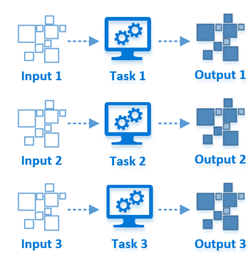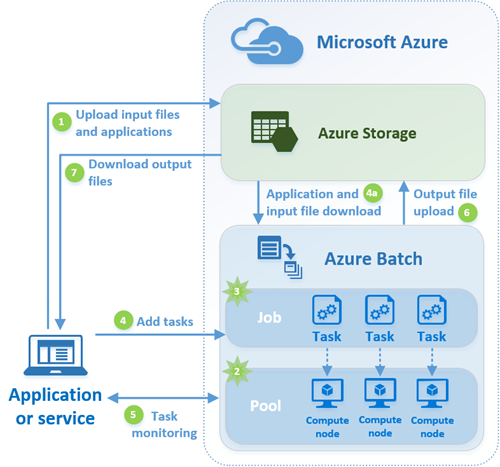Azure Batch enables you to run large-scale parallel and high performance computing (HPC) applications efficiently in the cloud. It's a platform service that schedules compute-intensive work to run on a managed collection of virtual machines, and can automatically scale compute resources to meet the needs of your jobs.
With the Batch service, you programmatically define Azure compute resources to execute large-scale batch jobs. You can run these jobs on demand or on a schedule, and you don't need to manually configure and manage an HPC cluster, individual virtual machines, virtual networks, or a job scheduler.
Batch is a managed Azure service that is used for batch processing or batch computing--running a large volume of similar tasks to get some desired result. Batch computing is most commonly used by organizations that regularly process, transform, and analyze large volumes of data.
Batch works well with intrinsically parallel (also known as "embarrassingly parallel") applications and workloads. Intrinsically parallel workloads are easily split into multiple tasks that perform work simultaneously on many computers.
Some examples of workloads that are commonly processed using this technique are:
- Financial risk modeling
- Climate and hydrology data analysis
- Image rendering, analysis, and processing
- Media encoding and transcoding
- Genetic sequence analysis
- Engineering stress analysis
- Software testing
Batch can also perform parallel calculations with a reduce step at the end, as well as execute more complex HPC workloads such as Message Passing Interface (MPI) applications.
For a comparison between Batch and other HPC solution options in Azure, see Batch and HPC solutions.
When you build solutions that use Azure Batch for parallel workload processing, you do so programmatically using the Batch APIs. With the Batch APIs, you create and manage pools of compute nodes (virtual machines) and schedule jobs and tasks to run on those nodes. A client application or service that you author uses the Batch APIs to communicate with the Batch service. You can efficiently process large-scale workloads for your organization, or provide a service front-end to your customers so that they can run jobs and tasks--on demand, or on a schedule--on one, hundreds, or thousands of nodes. You can also use Batch as part of a larger workflow, managed by tools such as Azure Data Factory.
[AZURE.TIP] When you are ready to dig in to the Batch API for a more in-depth understanding of the features it provides, check out the Azure Batch feature overview.
When you develop Batch solutions, you'll use the following accounts in Microsoft Azure.
-
Azure account and subscription - If you don't already have an Azure subscription, you can activate your MSDN subscriber benefit, or sign up for a free Azure account. When you create an account, a default subscription will be created for you.
-
Batch account - When your applications interact with the Batch service, the account name, the URL of the account, and an access key are used as credentials. All of your Batch resources such as pools, compute nodes, jobs, and tasks are associated with a Batch account. You can create and manage a Batch account in the Azure portal.
-
Storage account - Batch includes built-in support for working with files in Azure Storage. Nearly every Batch scenario will use Azure Storage for file staging--for the programs that your tasks run, and for the data that they process--and for the storage of output data that your tasks generate. To create a Storage account, see About Azure storage accounts.
To build solutions using Azure Batch, you can use the Batch .NET client libraries, PowerShell, or even issue direct REST API calls. Use any or all of these tools to develop client applications and services that run jobs in Batch.
-
Batch .NET client library - Most Batch solutions are built using the Batch .NET client library, which is available via NuGet.
-
Batch Management .NET client library - Also available via NuGet, use the Batch Management .NET client library to programmatically manage Batch accounts in your client applications or services.
-
Batch REST API - The Batch REST APIs provide all of the same functionality as the Batch .NET client library. In fact, the Batch .NET library itself uses the Batch REST API under the hood to interact with the Batch service.
-
Batch PowerShell cmdlets - The Azure Batch cmdlets in the Azure PowerShell module enable you to manage Batch resources with PowerShell.
-
Azure Batch Explorer - The Batch Explorer is one of the Batch .NET sample applications available on GitHub. Build this Windows Presentation Foundation (WPF) application with Visual Studio 2013 or 2015, and use it to browse and manage the resources in your Batch account while you are developing and debugging your Batch solutions. View job, pool, and task details, download files from compute nodes, or even connect to nodes remotely by using Remote Desktop (RDP) files that you obtain with just a few clicks in the Batch Explorer interface.
-
Microsoft Azure Storage Explorer - While not strictly an Azure Batch tool, the Storage Explorer is another valuable tool to have while you are developing and debugging your Batch solutions.
A common solution that uses the Batch APIs to interact with the Batch service involves scaling out intrinsically parallel work--such as the rendering of images for 3D scenes--on a pool of compute nodes. This pool of compute nodes can be your "render farm" that provides tens, hundreds, or even thousands of cores to your rendering job, for example.
The following diagram shows a common Batch workflow, with a client application or hosted service using Batch to run a parallel workload.
In this common scenario, your application or service processes a computational workload in Azure Batch by performing the following steps:
-
Upload the input files and the application that will process those files to your Azure Storage account. The input files can be any data that your application will process, such as financial modeling data, or video files to be transcoded. The application files can be any application that is used for processing the data, such as a 3D rendering application or media transcoder.
-
Create a Batch pool of compute nodes in your Batch account--these are the virtual machines that will execute your tasks. You specify properties such as the node size, their operating system, and the location in Azure Storage of the application to install when the nodes join the pool (the application that you uploaded in step #1). You can also configure the pool to automatically scale--dynamically adjust the number of compute nodes in the pool--in response to the workload that your tasks generate.
-
Create a Batch job to run the workload on the pool of compute nodes. When you create a job, you associate it with a Batch pool.
-
Add tasks to the job. When you add tasks to a job, the Batch service automatically schedules the tasks for execution on the compute nodes in the pool. Each task uses the application that you uploaded to process the input files.
- 4a. Before a task executes, it can download the data (the input files) that it is to process to the compute node it is assigned to. If the application has not already been installed on the node (see step #2), it can be downloaded here instead. When the downloads are complete, the tasks execute on their assigned nodes.
-
As the tasks run, you can query Batch to monitor the progress of the job and its tasks. Your client application or service communicates with the Batch service over HTTPS, and because you might be monitoring thousands of tasks running on thousands of compute nodes, be sure to query the Batch service efficiently.
-
As the tasks complete, they can upload their result data to Azure Storage. You can also retrieve files directly from compute nodes.
-
When your monitoring detects that the tasks in your job have completed, your client application or service can download the output data for further processing or evaluation.
Keep in mind that this is just one way to use Batch, and this scenario describes only a few of its available features. For example, you can execute multiple tasks in parallel on a each compute node, and you can use job preparation and completion tasks to prepare the nodes for your jobs, then clean up afterward.
Now that you've seen an example Batch scenario, it's time to dig deeper into the service to learn how you can use it to process your compute-intensive parallel workloads.
-
Get started with the Azure Batch library for .NET to learn how to use C# and the Batch .NET library to perform the techniques described above. This should be one of your first stops while learning how to use the Batch service.
-
Check out the Batch feature overview to get more in-depth information on the API features that Batch provides for processing your compute intensive workloads.
-
In addition to the Batch Explorer, the other code samples on GitHub show you how to use many of the Batch features using the Batch .NET library.
-
Check out the Batch Learning Path to get an idea of the resources available to you as you learn to work with Batch.

